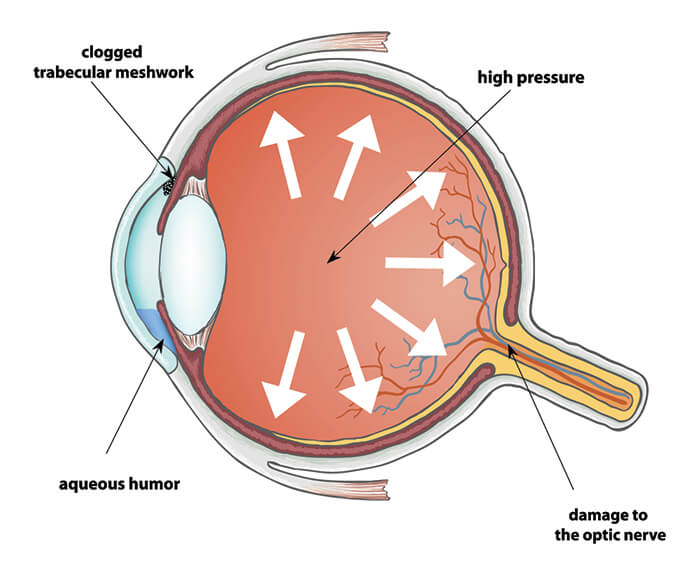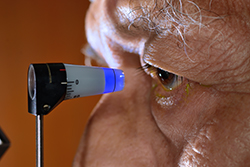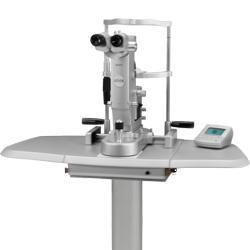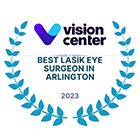Glaucoma is one of the leading causes of blindness throughout the world, affecting approximately 2% of the population over the age of 40. Unlike many other eye diseases, conditions or problems, glaucoma begins without any symptoms or obvious loss of vision. Thus, early detection of glaucoma is extremely important to prevent permanent loss of vision. This disease can often be successfully treated, and blindness prevented, when diagnosed early enough.
What is Glaucoma?
Glaucoma is a group of diseases that can damage the eye’s optic nerve and result in vision loss and blindness. Glaucoma occurs when the normal fluid in the eye cannot drain properly and the pressure inside the eyes slowly rises. However, with early glaucoma treatment, you can often protect your eyes against serious vision loss. If you believe that you may have glaucoma symptoms, contact the glaucoma specialists at Silk Vision in Alexandria, Annandale or Manassas.

What is the optic nerve?
The optic nerve is a bundle of more than 1 million nerve fibers. It connects the retina to the brain. The retina is the light-sensitive tissue at the back of the eye. A healthy optic nerve is necessary for good vision.
What are some other forms of glaucoma?
Open-angle glaucoma is the most common form. Some people have other types of the disease.
- Low-tension or normal-tension glaucoma. Optic nerve damage and narrowed side vision occur in people with normal eye pressure. Lowering eye pressure at least 30 percent through medicines slows the disease in some people. Glaucoma symptoms may worsen in others despite low pressures. A comprehensive medical history is important in identifying other potential risk factors, such as low blood pressure, that contribute to low-tension glaucoma. If no risk factors are identified, glaucoma treatment options for low-tension are the same as for open-angle glaucoma.
- Angle-closure glaucoma. The fluid at the front of the eye cannot reach the angle and leave the eye. The angle gets blocked by part of the iris. People with this type of glaucoma have a sudden increase in eye pressure. Symptoms include severe pain and nausea, as well as redness of the eye and blurred vision. If you have these symptoms, you need to seek treatment immediately. This is a medical emergency. If your doctor is unavailable, go to the nearest hospital or clinic. Without treatment to improve the flow of fluid, the eye can become blind in as few as one or two days. Usually, prompt laser surgery and medicines can clear the blockage and protect sight.
- Congenital glaucoma. Children are born with a defect in the angle of the eye that slows the normal drainage of fluid. These children usually have obvious glaucoma symptoms, such as cloudy eyes, sensitivity to light, and excessive tearing. Conventional glaucoma surgery typically is the suggested glaucoma treatment, because glaucoma medicines may have unknown effects in infants and be difficult to administer. Glaucoma surgery is safe and effective. If glaucoma surgery is done promptly, these children usually have an excellent chance of having good vision.
Secondary Glaucoma
These can develop as complications of other medical conditions. These types of glaucomas are sometimes associated with eye surgery or advanced cataracts, eye injuries, certain eye tumors, or uveitis (eye inflammation). Pigmentary glaucoma occurs when pigment from the iris flakes off and blocks the meshwork, slowing fluid drainage. A severe form, called neovascular glaucoma, is linked to diabetes. Corticosteroid drugs used to treat eye inflammations and other diseases can trigger glaucoma symptoms in some people. Treatment includes medicines, glaucoma laser surgery, or conventional glaucoma surgery.
Glaucoma Causes and Risk Factors
How does open-angle glaucoma damage the optic nerve?
In the front of the eye is a space called the anterior chamber. A clear fluid flows continuously in and out of the chamber and nourishes nearby tissues. The fluid leaves the chamber at the open angle where the cornea and iris meet. (See diagram below.) When the fluid reaches the angle, it flows through a spongy meshwork, like a drain, and leaves the eye.
Sometimes, when the fluid reaches the angle, it passes too slowly through the meshwork drain. As the fluid builds up, the pressure inside the eye rises to a level that may damage the optic nerve. When the optic nerve is damaged from increased pressure, open-angle glaucoma–and vision loss–may result. That’s why controlling the pressure inside the eye is important.
Does increased eye pressure mean that I have glaucoma?
Not necessarily. Increased eye pressure means you are at risk for glaucoma but does not mean you have the disease. A person has glaucoma only if the optic nerve is damaged. If you have increased eye pressure but no damage to the optic nerve, you do not have glaucoma. However, you are at risk. Follow the advice of a glaucoma specialist.
Can I develop glaucoma if I have increased eye pressure?
Not necessarily. Not every person with increased eye pressure will develop glaucoma. Some people can tolerate higher eye pressure better than others. Also, a certain level of eye pressure may be high for one person but normal for another.
Whether you develop glaucoma depends on the level of pressure your optic nerve can tolerate without being damaged. This level is different for each person. That’s why a comprehensive dilated eye exam is very important. It can help your glaucoma specialist determine what level of eye pressure is normal for you.
Can I develop glaucoma without an increase in my eye pressure?
Yes. Glaucoma can develop without any glaucoma symptoms like increased eye pressure. This form of glaucoma is called low-tension or normal-tension glaucoma. It is not as common as open-angle glaucoma. Ask your glaucoma specialist for more information and glaucoma treatment options.
Who is at risk for glaucoma?
Anyone can develop glaucoma. Some people are at higher risk than others. They include:
- African Americans over age 40.
- Everyone over age 60, especially Mexican Americans.
- People with a family history of glaucoma.
Among African Americans, studies show that glaucoma symptoms are:
- Five times more likely to occur in African Americans than in Caucasians.
- About four times more likely to cause blindness in African Americans than in Caucasians.
- Fifteen times more likely to cause blindness in African Americans between the ages of 45-64 than in Caucasians of the same age group.
A comprehensive dilated eye exam can reveal more glaucoma risk factors, such as high eye pressure, the thinness of the cornea, and abnormal optic nerve anatomy. In some people with certain combinations of these high-risk factors, medicines in the form of eye drops reduce the risk of developing glaucoma by about half.
Medicare covers an annual comprehensive dilated eye exam for some people at high risk for glaucoma.
What can I do to protect my vision?
Studies have shown that the early detection and treatment of glaucoma before it causes major vision loss, is the best way to control the disease. So, if you fall into one of the high-risk groups for the disease, make sure to have your eyes examined through dilated pupils every two years by an eye care professional.
If you are undergoing glaucoma treatment, be sure to take your glaucoma medicine every day. See your glaucoma specialist regularly.
You also can help protect the vision of family members and friends who may be at high risk for glaucoma–African Americans over age 40; everyone over age 60, especially Mexican Americans; and people with a family history of the disease. Encourage them to have a comprehensive dilated eye exam by an experienced glaucoma specialist at least once every two years. Remember: Lowering eye pressure in glaucoma’s early stages slows progression of the disease and helps save vision.
Glaucoma Symptoms and Detection
What are the symptoms of glaucoma?
At first, there are no glaucoma symptoms. Vision stays normal, and there is no pain. However, as the disease progresses, a person with glaucoma may notice his or her side vision gradually failing. That is, objects in front may still be seen clearly, but objects to the side may be missed. As glaucoma remains untreated, people may miss objects to the side and out of the corner of their eye. Without treatment, people with glaucoma will slowly lose their peripheral (side) vision. They seem to be looking through a tunnel. Over time, straight-ahead vision may decrease until no vision remains.
Glaucoma can develop in one or both eyes.

How is glaucoma detected?
Glaucoma is detected through a comprehensive eye exam by an experienced glaucoma specialist that includes:
- Visual acuity test. This eye chart test measures how well you see at various distances. A tonometer measures pressure inside the eye to detect glaucoma.
- Visual field test. This test measures your side (peripheral) vision. It helps your eye care professional tell if you have lost side vision, a sign of glaucoma.
- Dilated eye exam. Drops are placed in your eyes to widen, or dilate, the pupils. Your eye care professional uses a special magnifying lens to examine your retina and optic nerve for signs of damage and other eye problems. After the exam, your close-up vision may remain blurred for several hours.
- Tonometry. An instrument (right) measures the pressure inside the eye. Numbing drops may be applied to your eye for this test.
- Pachymetry. A numbing drop is applied to your eye. Your eye care professional uses an ultrasonic wave instrument to measure the thickness of your cornea.
Glaucoma Treatment
Immediate glaucoma treatment for early stage, open-angle glaucoma can delay progression of the disease. That’s why early diagnosis is very important. Glaucoma treatments include medicines, glaucoma laser trabeculoplasty, conventional glaucoma surgery, or a combination of any of these. While these treatments may save remaining vision, they do not improve sight already lost from glaucoma.
Medicines
Medicines, in the form of eye drops or pills, are the most common early glaucoma treatment. Some glaucoma medicines cause the eye to make less fluid. Others lower pressure by helping fluid drain from the eye. Before you begin glaucoma treatment, tell your eye care and glaucoma specialist about other medicines you may be taking. Sometimes the drops can interfere with the way other medicines work. Glaucoma medicines may be taken several times a day. Most people have no problems. However, some glaucoma medicines can cause headaches or other side effects. For example, drops may cause stinging, burning, and redness in the eyes. Many drugs are available for glaucoma treatment. If you have problems with one glaucoma medicine, tell your glaucoma specialist. Glaucoma treatment with a different dose or a new drug may be possible. Because glaucoma often has no symptoms, people may be tempted to stop taking or may forget to take their medicine. You need to use the drops or pills as long as they help control your eye pressure. Regular use of your glaucoma medicine is very important. If you are unsure of how to use your eye drops, ask your glaucoma specialist to show you how to correctly put them in your eye.

Laser trabeculoplasty
Glaucoma laser trabeculoplasty helps fluid drain out of the eye. Your glaucoma specialist may suggest this step at any time. In many cases, you need to keep taking glaucoma medicine after this procedure.
Laser trabeculoplasty is performed in your glaucoma specialist’s office or eye clinic. Before the glaucoma laser surgery, numbing drops will be applied to your eye. As you sit facing the laser machine, your doctor will hold a special lens to your eye. A high-intensity beam of light is aimed at the lens and reflected onto the meshwork inside your eye. You may see flashes of bright green or red light. The laser makes several evenly spaced burns that stretch the drainage holes in the meshwork. This allows the fluid to drain better.
Like any surgery, glaucoma laser surgery can cause side effects, such as inflammation. Your doctor may give you some drops to take home for any soreness or inflammation inside the eye. You need to make several follow-up visits with your glaucoma specialist to have your eye pressure monitored. If you have glaucoma in both eyes, only one eye will receive glaucoma laser surgery at a time. Laser treatments for each eye will be scheduled several days to several weeks apart. Studies show that glaucoma laser surgery is very good at reducing the pressure in some patients. However, its effects can wear off over time. The glaucoma specialists at Silk Vision may suggest further glaucoma treatment.
Conventional Glaucoma Surgery
Conventional glaucoma surgery makes a new opening for the fluid to leave the eye. Your glaucoma specialist may suggest this glaucoma treatment at any time. Conventional surgery often is done after glaucoma medicines and glaucoma laser surgery has failed to control pressure. Conventional glaucoma surgery is performed in an eye clinic or hospital. The glaucoma specialists at Silk Vision can perform this procedure for you. Before the glaucoma surgery, you will be given medicine to help you relax. Your doctor will make small injections around the eye to numb it. A small piece of tissue is removed to create a new channel for the fluid to drain from the eye.
For several weeks after the glaucoma surgery, you must put drops in the eye to fight infection and inflammation. These drops will be different from those you may have been using before your glaucoma surgery.
As with glaucoma laser surgery, conventional surgery is performed on one eye at a time. Usually, the operations are four to six weeks apart. Conventional glaucoma surgery is about 60 to 80 percent effective at lowering eye pressure. If the new drainage opening narrows, a second glaucoma surgery may be needed. Conventional glaucoma surgery works best if you have not had previous eye surgery, such as a cataract operation.
In some instances, your vision may not be as good as it was before conventional glaucoma surgery. Conventional glaucoma surgery can cause side effects, including cataracts, problems with the cornea, and inflammation or infection inside the eye. The buildup of fluid in the back of the eye may cause some patients to see shadows in their vision. If you have any of these problems, tell your doctor so a treatment plan can be developed. Conventional glaucoma surgery makes a new opening for the fluid to leave the eye.
iStent
What is the iStent?
High IOP (intraocular pressure) is the only known controllable factor during glaucoma treatment, and is also the #1 risk factor in glaucoma patients. High IOP is commonly caused by a reduction in aqueous outflow in the trabecular meshwork of the eye, which is located near the base of the cornea. One product, the iStent, represents a huge advancement in the treatment of high IOP related to glaucoma, and we are pleased to offer this glaucoma treatment option at the Silk Vision and Surgical Center at our three locations in Alexandria, Annandale or Manassas.
The iStent is the smallest known, FDA-approved medical device; made of titanium and only 120 microns in diameter, the iStent is used to create a permanent opening in the eye’s trabecular meshwork, allowing fluid to pass through and flow into Schlemm’s canal. This increases aqueous outflow through the eye’s normal pathway, decreasing high intraocular pressure (IOP).
Benefits of the iStent include:
- Comfort: you cannot see or feel the iStent once it has been implanted into your eyes
- Convenience: The iStent is implanted during cataract surgery, adding a mere ten minutes to the procedure and reducing the need for multiple surgeries. The procedure is minimally invasive and requires no more incisions than those already required for cataract surgery.
- Safety: There is no additional risk added to cataract surgery when an iStent implant is included.
- Recovery: Recovery time necessary for the iStent procedure is less than that of a majority of glaucoma-related procedures.
- Relief: Most patients see a reduction in intraocular pressure, as well as a reduction in the medications used to manage and treat glaucoma after the procedure.
- The iStent does not limit future treatment options in glaucoma patients.













.png)
